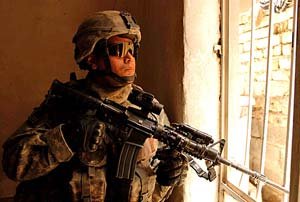
U.S. Army Spc. Antonio Garcia, from San Angelo, Texas, a paratrooper with Company C, 2nd Battalion, 325th Airborne Infantry Regiment, 2nd Brigade Combat Team, 82nd Airborne Division, pulls security while his platoon leader talks to the owner of a house during a cordon and search operation in Sha’ab, Baghdad, May 2007. U.S. Army photo by Sgt. Michael Pryor
By Sgt. Michael Pryor
2nd Brigade Combat Team, 82nd Airborne Division
BAGHDAD — In the first days after his battalion began operating in east Baghdad’s Sha’ab neighborhood, Capt. Will Canda said he often saw the beds of Iraqi police trucks stained red with dried blood.
“It was like they had just come from a butcher shop,” said Canda, a Westcliffe, Colo. native and commander of Company B, 2nd Battalion, 325th Airborne Infantry Regiment.
Like wagons rolling through plague-stricken villages in medieval times, the police trucks were being used to pick up the bodies of murder victims found littering the neighborhood.
That was in February, when Canda’s battalion became one of the first units to move into a battle space as part of Operation Fardh al Qanoon – which translated, means “enforcing the law” and is the name for the strategy to stabilize violence in Baghdad by pushing thousands of additional U.S. and Iraqi forces into the city’s neighborhoods.
Since then, troops have continued to pour in, dotting Baghdad with small outposts and joint security stations.
Top U.S. commanders have cautioned that any verdict on the overall success of the plan will have to wait until after all units are in place and conducting operations. But Canda and his paratroopers have been on the ground long enough to begin drawing their own conclusions.
Three months after they arrived in Sha’ab, the bodies are gone, the murders have stopped, and the neighborhood has come back to life, Canda said.
“It’s night and day from when we got here,” he said.
It’s an impressive claim considering the challenges facing the paratroopers when they first arrived here in early February.
One obvious problem was the sheer size of the region. The battalion’s area of operations comprises a huge section of east Baghdad, including the Sha’ab, Ur, and Sadr City neighborhoods.
Twenty percent of the city’s total population lives within this area of operation, said Maj. Trey Rutherford, the battalion’s operations officer. That equals out to a rough ratio of one paratrooper for every 26,000 Iraqis.
But the numbers weren’t the paratroopers’ only obstacle. They also faced an entrenched and hostile militia organization, an inefficient local government and a breakdown in essential services for the population.
None of these problems have been completely solved yet, Rutherford said.
“We’ve still got a ways to go,” he said.
But, he said, the accomplishments are already starting to pile up. The battalion has sent almost 200 criminals into the Iraqi justice system. People in the area are slowly beginning to look to the government for protection, rather than the militias. The economy is booming, thanks to improved protective measures at the markets. And the local government is starting to play a more active role, beginning at the neighborhood advisory council level, Rutherford said.
Most importantly, said Canda, security has improved. Life for the people of Sha’ab is returning to normal, to the way it was before the killing and bombings turned a walk to the market into a life or death gamble.
“I know that we’ve made a difference and made this area safer. Every time I go out, people tell me that,” said Spc. Herrick Lidstone, of Littleton, Colo., a radio operator with Bravo Company.
The battalion runs operations out of Coalition Outpost Callahan, a fortress-like building that was once an upscale shopping center. The place was empty and abandoned when the paratroopers arrived, but it’s now a constant blur of activity.
Day and night, the stairs are crowded with soldiers either on their way out on a mission or coming in from one. The whirring, clanging, hammering sounds of the motor pool continually echo through the COP as mechanics patch up damaged vehicles for the next patrol.
Each time the paratroopers leave the wire, the mission is different.
A typically hectic day might find them handing out Tylenol and tooth brushes at a medical assistance operation in the morning, doing detective work to track down members of a bomb-making cell in the afternoon, and kicking in doors on a full-combat raid at night.
“We ask them to do a thousand different things,” said Rutherford, “and we ask them to do it every single day.”
It’s a steep learning curve, said 1st Lt. Andrew Smith, a platoon leader with Charlie Company from Apopka, Fla.
“When I leave Iraq, I’ll have been a salesman, a cop, a politician, and a school principal,” Smith said.
Some of the paratroopers wish they could hand the “hearts & minds” missions off to some other unit.
“I didn’t sign up to hand out soccer balls,” said one sergeant.
But gaining the support of the population is the key to making the surge work, said Sgt. John Reed, a Bravo Company squad leader from Sanford, Fla. The people are the base that military, political, and economic progress has to be built on, he said.
“Without a base, without a foundation, you have nothing,” Reed said.
The results of the paratroopers’ efforts to engage the population are clearest during their daily patrols through the zigzagging streets of Sha’ab. Out on the streets, where people used to lock their doors in fright when Americans appeared, the paratroopers are now greeted warmly.
One afternoon 1st Lt. Rusty Bodine, of Fairfax, Va., was out trying to get residents to fill out an employment survey.
He knocked on one door and was welcomed in by the man of the house, who was dressed in a rumpled shirt and bare feet. He looked like he might have just woken up. While he looked at the survey, his sons brought out extra chairs and stools for the paratroopers to sit down.
While Bodine and the man talked, Reed and Sgt. Unberto Espinoza wandered into the next room. The man’s wife was there watching television surrounded by three of her children and several neighborhood kids. The kids swarmed around the two paratroopers, barraging them with questions.
“What is your name?” “Where is your home?” “You speak Arabic?”
Two teenage daughters peeked their heads out from behind a curtain, then disappeared again, giggling, when the paratroopers looked back. Stools and chairs were brought out, then cups of tea. When one of the paratroopers took out a picture of his baby son, the whole family passed it around, each one giving it a little kiss.
When it was time to leave, the family asked the paratroopers to come back the next day. They waved from the doorstep as the trucks drove away.
Inside the Humvees, everyone was feeling good. At more and more houses, they were getting similar receptions. Each one was a little victory for the paratroopers, who had worked hard to bring the people to their side.


Wild Thing’s comment………
Stories like this the Media and the liars about our troops would rather die then tell us about. Stories of the success of our troops no matter how big or small, or how many times our troops WIN battles, take caches of weapons and capture insurgents is just too much for our terrorist loving Media to admit to. And God forbid people like Pelosi, Reid and Murtha etc. would tell about these things when they go on political talk shows to push THEIR agenda of how we cannot win and never will.

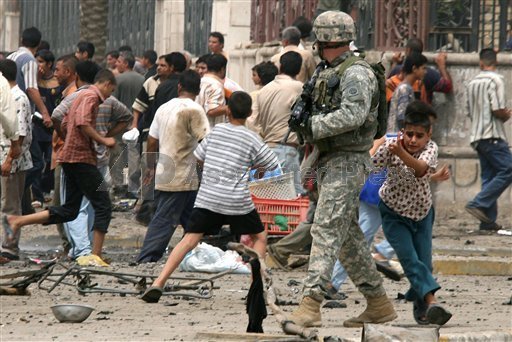
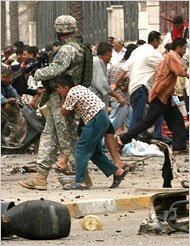
 The boy knows who will not kill him but will save him. This must disappoint the wishes of the cut and run crowd, to see one of our very brave soldiers standing tall and the child knowing where he can get behind him to be safe. God bless all our troops!!
The boy knows who will not kill him but will save him. This must disappoint the wishes of the cut and run crowd, to see one of our very brave soldiers standing tall and the child knowing where he can get behind him to be safe. God bless all our troops!!




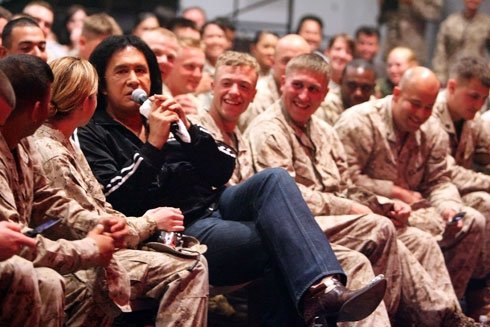



 …..Thank you John5 ( VN 69/70)
…..Thank you John5 ( VN 69/70)
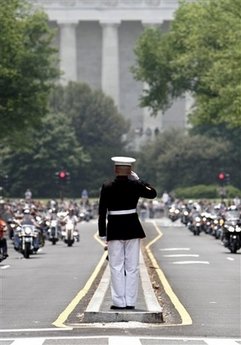
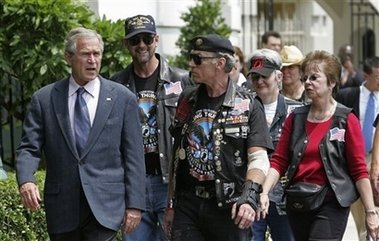
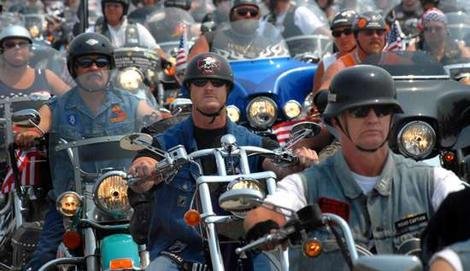
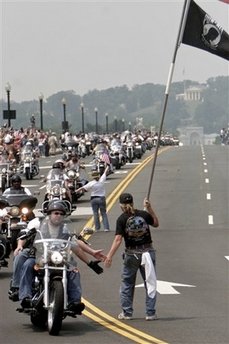 The ponytails might have grayed, and they’re not as lithe as they were 40 years ago, but for the Harley-riding Vietnam veterans who descend on Washington for Memorial Day, it’s a chance to remember and reflect on the war that changed their generation.
The ponytails might have grayed, and they’re not as lithe as they were 40 years ago, but for the Harley-riding Vietnam veterans who descend on Washington for Memorial Day, it’s a chance to remember and reflect on the war that changed their generation.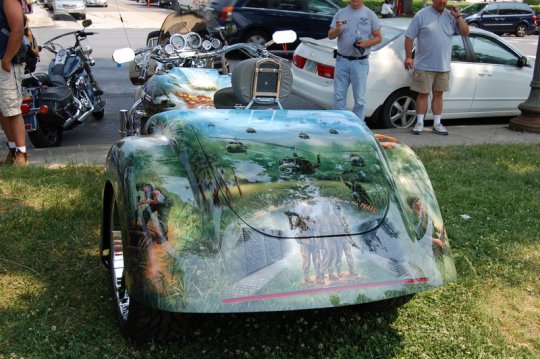

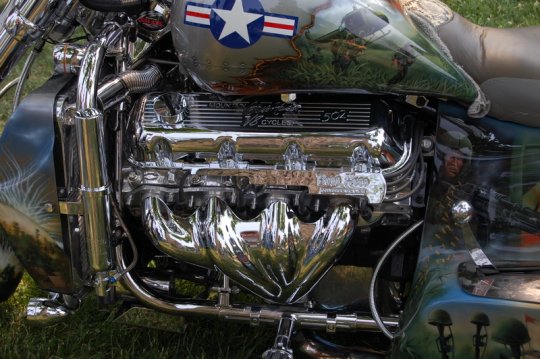


Recent Comments